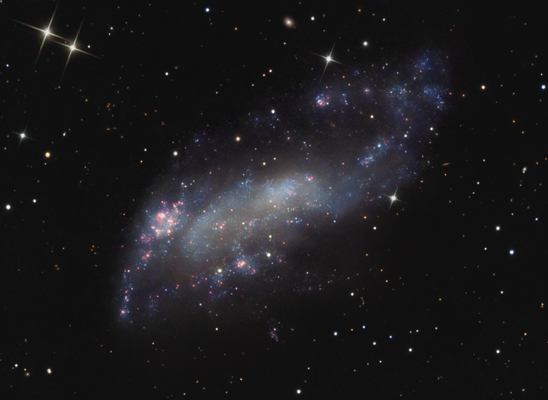
RA: 10h 28m 22.7s Dec: +68° 25' 00 Mag: 10.8 , Size: 12.3' x 5.9', Distance: ~13 million ly

RA: 10h 28m 22.7s Dec: +68° 25' 00 Mag: 10.8 , Size: 12.3' x 5.9', Distance: ~13 million ly
IC 2574 discovered by Edwin Coddington in 1898 and classified first as a nebula is actually a dwarf irregular galaxy in the constellation Ursa Major and is part of the M81 group of galaxies. This long exposure image of this classification type SAB(s)m shows two very dim arms and irregular shape. To the north (top left)
is an area of massive star formations surrounded by interstellar medium (ISM) and thought to be triggered by the central stellar cluster and because if its large size it is classified as a 'Super Giant Shell' (SGS).
An extract taken from a study by S. Steward & F. Walter 2000: In the standard picture (e.g., Weaver et al. 1977; McKee & Ostriker 1977; Chu et al.1995), these structures are believed to be created by young star-forming regions that supposedly eject a great amount
of mechanical energy into the ambient ISM in terms of strong stellar winds and subsequent supernova (SN) explosions.
| Location & Date |
Backyard, Abbott Observatory - March 2011 Temperature - Low 30's F |
| Telescope |
Deep Sky Instruments RC10C , F/7.3, Losmandy G11 Gemini, Prime Focus,
Image scale 0.82 arcsec/pixel |
| Camera |
SBIG ST-2000XM w/CFW8, AO8 Baader HaLRGB AR Filters CCD temp -25°C |
| Exposure Times | (Ha) 8x15m (Lum) 28x15m (R)13x15m (G) 8x15m (B) 17x15m Bin 1x1 |
| Other Information |
Image planning - CCD Navigator Image acquisition/focus/guiding/dither - CCD Autopilot4 w/CCDSoft/TheSky6/PinPoint |
| Image Processing |
* CCDStack- Calibration, Normalize, Alignment, Mean Combine, Deconvolution * FITS Liberator 3 - stretching * Adobe CS4 - L+(Ha+R),GB combine, Levels, Curves, Sharpening, Noise reduction, JPEG conversion |